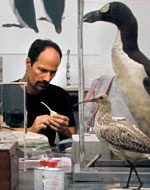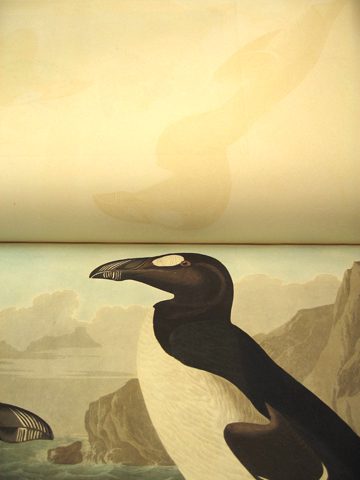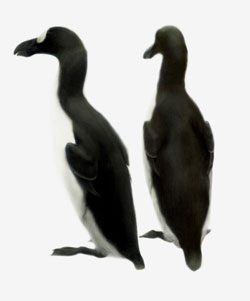Lost Bird Project: One artist’s meeting with Audubon’s $8 million tome
By Todd McGrain, artist January 26, 2012When the gavel fell last week at the auction of John James Audubon’s “The Birds of America” the price for the rare first edition was almost $8 million—the third highest sum ever paid at auction for a book. But what a book! Its phenomenal size and heft simply doesn’t come through in photos, but the 435 life-size portraits Audubon painted are enormous, reproduced on “double elephant” stock to create a tome that’s some four feet on a side.
Few people get to see one of these first editions in person (only 120 remain), but among them is Cornell art professor Todd McGrain. As part of his initial research for his Lost Bird Project, McGrain was allowed to view Cornell University’s copy, held in the Carl A. Kroch Library. The project is McGrain’s ongoing effort to memorialize, through a range of art forms, birds that have been driven to extinction. In the video above, you can get a feel for the size and beauty of the volume as you watch two white-gloved librarians carry it out for McGrain and carefully turn the pages. For McGrain, it was an opportunity to reflect on Audubon’s artistry, and on a curious and poignant alteration that time has made to Audubon’s great work. Here’s Todd:

I arrived at the library with high expectations, but I still wasn’t prepared for the book’s profound beauty. Not only are the individual images much larger and more colorful than I had expected, they are also more handcrafted. Loose brush marks rest fluidly within the intricate black printing. These marks, made by professional colorists, are at the same time gestural and assured with an ease that only comes with great mastery. The book as a whole is a marvel. Leather binding with gold leaf trim offers the prints a context of grandeur and authority.
With white protective gloves and synchronized movements, Curator David Corson and his assistant Evan Earle folded back the pages. It was difficult to pass by prints without affording each a full inspection. I had, however, come to see six particular birds and knew we needed to stay on task. The Great Auk, Labrador Duck, Heath Hen, Carolina Parakeet, Passenger Pigeon, and Eskimo Curlew were all depicted by Audubon. Today these birds are extinct.

Though Audubon was aware of and concerned about the plight of many species, his images are expressively optimistic—sentiments well suited for his era. Audubon’s was a time of perceived abundance and natural richness. My task as an artist working today is different. My challenge is to find an appropriate way to depict birds that will never be seen, a representation that suits birds that only exist in history and in art.
As the pages turned, I began to notice that the backs of many of the images were stained with a mirror shadow of the print upon which they rested. These ghost images were often quite soft and would have been difficult to identify if not adjacent to the original prints that created them. (You can see the faint image in the photo above.) The black ink of each print is slowly bleeding onto the sheet above. Through weight and time a new print is being formed. These impressions may only be soft recollections of the original, but in this softness I saw a tender companionship.
I began to recognize these ghost images as poetic equivalents to the relationship between memories and the events that inspire them. Perhaps the elemental, subtle silhouette is the best form to depict a creature lost but not forgotten? The ghost image of the Great Auk was particularly strong and poignant and became my inspiration for my own drawing of this lost bird.
I am honored to have had this chance to be inspired by this remarkable book, and I am glad to know that it is secure in the Cornell collection.
Along with many Audubon enthusiasts, I watched with interest as the bids climbed at the Christie’s auction. But the true value of this book remains its ability to inspire appreciation for the birds of America, including those we have lost to the tragedy of extinction.

All About Birds
is a free resource
Available for everyone,
funded by donors like you
American Kestrel by Blair Dudeck / Macaulay Library

